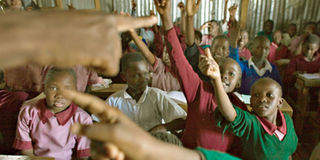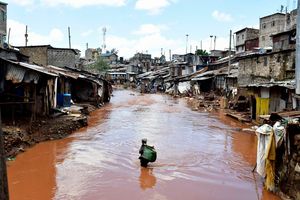Dropouts, repeats take toll on free primary education

There has been an incremental growth in the number of pupils proceeding to secondary schools to meet the government’s target of 70 per cent by last year. Photo/FILE
More than 400,000 pupils who enrolled in school under the free primary education programme did not complete Standard Eight last year.
According to the Economic Survey 2011, they were either forced to repeat or they dropped out.
Repeating a class, which is in contravention of set guidelines, was particularly high among pupils in Standard Six, standing at 14 per cent.
The economic survey tracked the first class of the free learning programme started in 2003 and established that only 59 per cent of the beneficiaries completed primary school last year.
“This causes concern on the high level of wastage in the education system, which can be attributed to repetition and dropouts,” the report says.
However, there has been an incremental growth in the number of pupils proceeding to secondary schools to meet the government’s target of 70 per cent by last year.
In 2010, some 9.4 million children were enrolled in Kenya’s 27,489 primary schools compared to the year 2009 when 26,667 schools admitted 8.8 million children.
The number of primary school teachers increased from 171,301 in 2009 to 184,873 as 13,960 were hired on contract basis.
Despite this increment, the pupil-to-teacher ratio remained at 45:1 while international best practice states that the number should be less than 40.
Some 8,732 teachers were either on leave or facing disciplinary action while 6,063 others were performing non-teaching duties.
Students enrolled in secondary schools last year were 1.7 million, up from 1.5 million, while the number of schools increased by about 327 to stand at 7,308.
“The improvement has been possible due to the expansion of policies for extra admission places in Form One,” the report says.
The number of secondary school teachers also rose by 4,200 to stand at 53,047.
On a critical note, the survey says that the teacher-to-student ratio deteriorated from 31:1 in 2009 to 32:1 in 2010.
Although the number of universities in Kenya did not increase last year, students enrolled in both the public and private institutions stood at 180,978, up from 177,735.
Affirmative action taken by the Joint Admissions Board that selects candidates for public universities resulted in an increase of female students from 52,945 to 53,873.
“Enrolment in the private universities continued to grow due to the demand for university education and the limited places in the public ones.”
A total of 37,848 students were enrolled in the private universities in the 2010/2011 academic year, compared to 35,179 students enrolled in 2009/2010.
There are seven public universities in the country and 12 chartered private ones with nine operating with letters of interim authority and three registered.
The public universities have 14 constituent colleges, which have resulted from the elevation of middle level colleges.
Interestingly, the number of middle level institutions, including polytechnics and technical training institutions, decreased from 89,023 to 82,843 in 2010.
But the demand for diploma courses continued to increase as 113 programmes were validated compared to only 50 in 2007.




